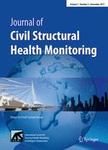版权所有:内蒙古大学图书馆 技术提供:维普资讯• 智图
内蒙古自治区呼和浩特市赛罕区大学西街235号 邮编: 010021

作者机构:Yokohama Natl Univ Dept Civil Engn Hodogaya Ku 79-5 Tokiwadai Yokohama Kanagawa 2408501 Japan Univ Tokyo Dept Civil Engn Bunkyo Ku Tokyo 2408501 Japan
出 版 物:《JOURNAL OF CIVIL STRUCTURAL HEALTH MONITORING》 (民用基础设施安全监测杂志)
年 卷 期:2012年第2卷第3-4期
页 面:163-173页
核心收录:
学科分类:08[工学] 0813[工学-建筑学] 0814[工学-土木工程]
主 题:Uncertainty quantification Model verification and validation Finite element model Global sensitivity analysis Bayesian inference
摘 要:With increasing number of aging civil structures including bridges, the finite element (FE) analysis assumes key roles in the use of the maintenance and repair design, and structural health monitoring. Despite the changes in dynamic characteristics of the aging structures from the nominal condition due to deteriorations or possible damages, limited attention has generally been paid to the verification and validation (V&V) of the numerical models used in the dynamic analysis. In this paper, we describe some practical considerations on the systematic V&V especially for the modeling of existing and aging bridges by applying a series of V&V procedure to the bridge FE model. The applied V&V procedure includes: (1) experimental data acquisition by impact tests, (2) model verification using grid convergence index, (3) sensitivity analysis to extract influential parameters to the comparative feature, namely the modal parameters, and (4) uncertainty quantification based on Bayesian inference. Posterior probability distributions of uncertain parameters in the FE model, especially material properties of the girders and slab, were then successfully derived in the uncertainty quantification procedure. The study also discusses some important considerations to improve implementation of V&V for the modeling of existing structures in terms of the verification procedure for complex FE models, the choice of comparative features, and the appropriate experimental data acquisition.